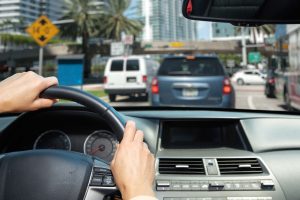More Than Half of All Car Crashes Happen in Intersections

Practicing safety at Massachusetts intersections.
If you traveled to Cape Cod or the North Shore this Memorial Day weekend, you most likely crossed many intersections and maybe a few rotaries.
Our Boston car accident attorneys want to take a moment and write about traveling safely through Massachusetts intersections. This is a fundamental, one of the first lessons for student drivers. Yet the reality is, more than 50 percent of all traffic crashes resulting in injuries or death occur in or near intersections, according to the U.S. Federal Highway Administration.
Intersections can be challenging. Drivers can make mistakes. Large trucks can take wide turns, causing serious accidents. And some intersections need improvements.
But often, accidents happen when drivers stop at traffic signals and just stop paying attention to the road. They may be fatigued; their thoughts may wander elsewhere. When traffic starts moving again, the driver may step on the gas without checking for pedestrians, cyclists or traffic around them.
Then there are outright reckless actions. Unfortunately, these endanger everyone in the intersection. These drivers are aggressive and may speed or drink and drive. These drivers may be cited for speeding and other traffic violations, but they can also be criminally charged for their actions. When a driver causes personal injury or death in Massachusetts, they may also be held liable for the victim’s injuries.
Massachusetts Laws for Driving Through Intersections
Travel Slowly. As a driver, always travel slow enough to stop or yield to pedestrians, cyclists and other vehicles. You also have to remember other bystanders on sidewalks, such as foot traffic from restaurants and shops. Be prepared for them to make an unexpected move.
Right of Way at Intersections. As a driver, you must understand when you have the right of way and when you have to yield in intersections. You can find some of the rules contained in M.G.L c. 89 § 8. As for right of way, when two vehicles arrive at an intersection at the same time, the driver on the left shall yield the right-of-way to the vehicle on the right.
Drivers must also yield to other vehicles before turning left. When stopped at a steady red light, drivers can make either a right turn or on a one-way street, they can make a left turn to another one way street. They must yield the right-of-way to pedestrians and other traffic as directed by the traffic signal.
Yielding to Cyclists. Drivers may only turn right if they can do so at a “safe distance from the bicyclist at a speed that is reasonable and proper,” according to M.G.L. c 90 § 14.
When drivers turn right near cyclists, there is a high risk for a right hook crash. As best practice, before making a right turn, drivers should fully check around their vehicle, including behind. They should make use of their rearview and sideview mirrors.
If there is a cyclist, they are most likely to be in the bike lane to your right (though in Massachusetts, cyclists are also allowed to travel in the traffic lane in front or behind you). Yield to them and let them turn right first. You want to keep the cyclist well ahead of you. Then travel slowly because there may be other cyclists nearby.
When drivers turn left, conditions are different. Drivers are most likely to encounter a cyclist coming from another direction. They can avoid a bicycle crash by continuing to scan the intersection and waiting until there are no cyclists.
Yielding to Pedestrians. Pedestrians are safest at intersections marked with crosswalks and traffic signals, which provide “Walk” lights. Drivers must stop at these traffic signals. M.G.L. c 89 § 11.
The best way to avoid a pedestrian accident is to stay well behind the crosswalk line and stay alert throughout the light. Do not check your cell phone, even in hands-free mode.
Put Down Your Cell Phone. Under the new Massachusetts hands-free law – or M.G.L. c 90 § 13B – drivers are not allowed to pick up their cell phones, including at stop signs or traffic signals. Drivers are allowed to use voice-activated technology, but we urge you to set your cell phone and all in-car systems aside. Let calls go to voicemail. Instead, use this time to check traffic conditions around you and get ready for the green light.
Read your Massachusetts Driver’s Manual. While this won’t make your summer reading list, the Massachusetts Driver’s Manual is available online. As a Massachusetts driver, you can access this anytime you have a question. We suggest reading page 111, which explains the Dutch Reach method for safety near cyclists and how to prevent a dooring injury to a cyclist. This is worth noting because cyclists and pedestrians may be traveling in different areas over the next few months as Massachusetts recovers from COVID-19.
About Breakstone, White & Gluck
Since 1992, our Boston car accident lawyers have represented victims of negligent or reckless driving, helping them recover financial compensation for injuries, lost wages, pain and suffering and other damages. We represent those injured in the Boston region, including in Boston, Cambridge, Somerville, Everett, Lynn, Quincy, Newton and Watertown. We also represent clients injured in Cape Cod car accidents.
For a free legal consultation, contact Breakstone, White & Gluck at 800-379-1244 or 627-723-7676. You can also use our contact form.

